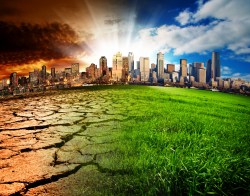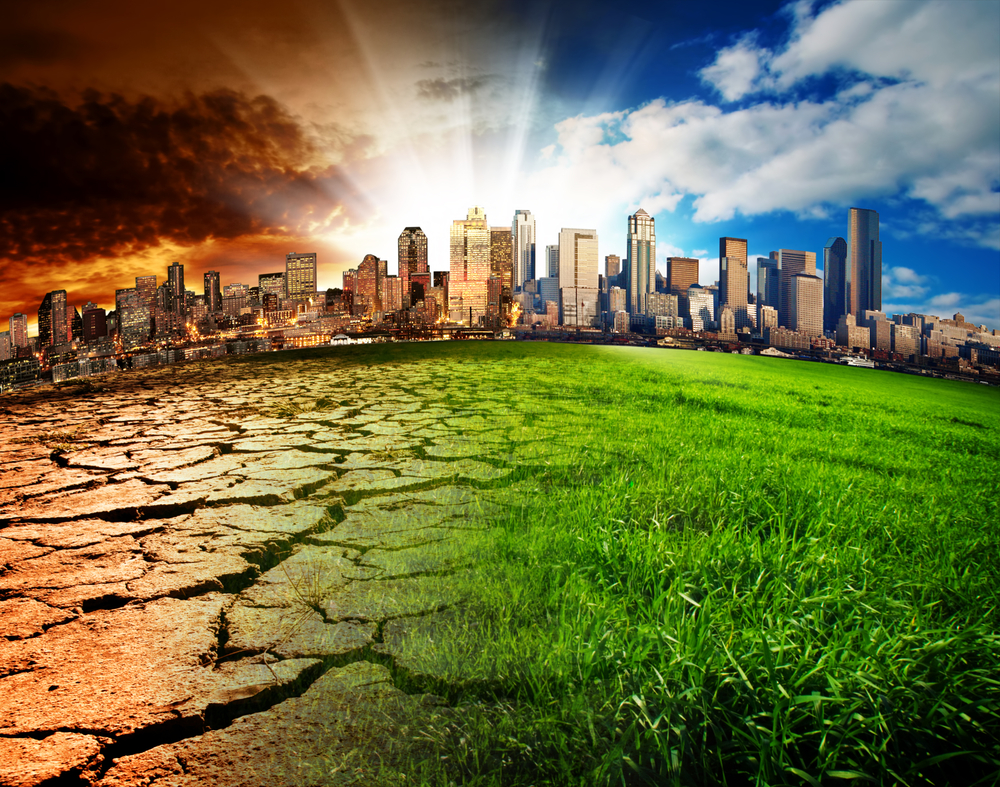
ShutterstockWe can we make good planning decisions in the face of climate uncertainty?
Making decisions about how and where to invest limited resources is always difficult, especially with a group of diverse stakeholders. It’s more difficult when, as in the case of infrastructure like bridges, sea walls, and sewer systems, the effects of the decisions can extend out for decades, even centuries. And it’s more difficult still when future conditions are subject to what I discussed in a previous post as “deep uncertainty.”
Deep uncertainty involves two basic conditions. First, the models we use to anticipate future conditions produce a wide range of scenarios of equal (or indeterminate) likelihood. There are, to quote my current favorite World Bank white paper, “multiple possible future worlds without known relative probabilities.” And second, stakeholders have divergent worldviews and irreconcilable differences about what counts as success, or an appropriate level of risk.
As you’ve no doubt noted, that’s the situation we face with climate change. We have to make decisions — political decisions, investment decisions — about things that will last 50, 100, even 200 years. Our models tell us that global ecosystems and climate are likely to change dramatically during that time. But they can not tell us exactly what shape that change will take, especially at the regional and local scale where decisions are typically made. “There is a scale misfit,” say the World Bankers, “between what can be provided by climate models and what is needed by decision-makers.” So we’re stuck planning for a future that is, at best, hazy.
The politicians and other leaders who make (or influence) such decisions do not like deep uncertainty. They do not like it, Sam I Am. They want something specific to plan for. Expert recommendations. Metrics, targets, and “deliverables.” Otherwise there’s no way to determine the most efficient use of resources, how to minimize costs and maximize benefits, which course is optimal. So they ask analysts for cost-benefit analysis (CBA).
CBA is useful in some circumstances, particularly where there are bounded time spans and known risks. But remember, there’s a difference between risk (statistically quantifiable) and uncertainty (not). It is the difference, if you will, between Rumsfeld’s “known unknowns” and his “unknown unknowns.”
As time horizons and uncertainty increase, CBA becomes less and less useful, more and more “a knob-twiddling exercise in optimizing outcomes,” as economist Martin Weitzman put it. Differences in social/political/ethical assumptions, like discount rates, start determining model outcomes. “Results from the CBA,” says the World Bank, are “extremely dependent on parameters on which there is no scientific agreement (e.g., the impact of climate change on hurricanes) or no consensus (e.g., the discount rate).” It’s still possible to construct models and get answers, but the danger becomes higher and higher of getting the wrong answer, i.e., optimizing for the wrong thing.
Consider the case of Ho Chi Minh City in Vietnam, highlighted in the aforementioned white paper:
Ho Chi Minh City (HCMC) ranks fourth globally among coastal cities most vulnerable to climate change. HCMC already experiences extensive routine flooding; in the coming decades, increased precipitation and rising sea levels could permanently inundate a large portion of the city, place the poor at particular risk, and threaten new economic development in low-lying areas.
In response to these challenges, HCMC has over the last fifteen years developed plans for, and started implementing, numerous infrastructure projects to mitigate the flood risk. The multi-billion dollar investment plans in sewage and drainage infrastructure included, over the years:
• 6000 km of canals and pipes covering 650 km2 in the city, to upgrade discharge capacity of the storm sewer system and to address land up-filling.
• Roughly 172 km dikes and river barriers, mainly for tidal control.
• A tide control plan that uses at least 12 gates and 170 km of dikes to create a polder system.These plans were based on the best predictions of future climate and development available to planners at the time.
Can you guess what happens next?
Recent analysis suggests, however, that climate change and urbanization will be larger than anticipated, and some variables are already beyond the maximum that were considered in the design phase. These surprises require significant revisions to the plans. At-risk infrastructure includes:
• The canals and pipes built principally to upgrade discharge capacity of the storm sewer system may not be able to handle increased flows.
• Increases in precipitation and tide levels observed over the last decade already exceed those projected and may over-top dikes and barriers.
• Future saline intrusion and rainfall intensity may be more severe than anticipated, potentially rendering the poldering plans obsolete even before they have been approved.Since the plan was created, the city has also experienced unprojected urbanization in low-density areas, perhaps due to the illusion of safety associated with the presence of flood prevention infrastructure. The HCMC Steering Committee for Flood Control (SCFC) is concerned the insufficiency of the planned infrastructure may worsen flooding in some areas of HCMC. In this case, the intervention’s legacy will have been an increase in vulnerability. [emphasis in original]
Lesson: If you spend a bunch of money optimizing for the wrong thing, it can be worse than doing nothing.
Now, whenever I criticize cost-benefit analysis, someone will ask, Well, what’s the alternative? What else can you do but weigh costs and benefits? How else would you make decisions?
Funny you should ask! Turns out the World Bank white paper everyone’s talking about has a great deal to say on that very subject. It describes various alternative decisionmaking procedures and gets into the weeds of some case studies. And if that doesn’t sate your nerd thirst, have no fear, the literature on climate change and uncertainty is extensive. Go nuts.
For the rest of you, though, I just want to focus on the top-line idea. It is this: Shift the focus from optimality to robustness. Rolls right off the tongue, no?
The optimal decision is the one that achieves the best cost-benefit ratio in a given set of conditions. A robust decision can be expected to hold up, and perform reasonably well, under a wide variety of possible conditions. To make the optimal decision, you must be able to quantify risks. When there is uncertainty rather than risk — “multiple possible future worlds without known relative probabilities” — one is better off with robust decisions.
The optimal decision aims for efficiency; the robust decision aims for resilience. A resilient solution may not be — probably won’t be — the one best suited for whatever circumstances do end up coming to pass. But it is, from the present-day perspective, the one most broadly suited to the widest array of possible futures.
An optimal solution is cost-effective, if you get it right (obviously). But strategies aiming for optimality are brittle. If you optimize for one thing and run into another, you risk degradation or collapse (or, like Ho Chi Minh City, just wasting a buttload of money). Robust decisions and investments often cost more in the short- to mid-term; the extra money is effectively spent as insurance against unforeseen outcomes. A robust solution retains its integrity in a wide array of circumstances.
When it comes to climate change, most economic models are premised on CBA — the search for efficiency. The World Bankers suggest an alternative, based on robustness, and yes, it involves yet another acronym: CIDA, or Climate Informed Decision Analysis, also known as “decision scaling.”
“As a process committed to acceptance of deep uncertainties,” they say, “CIDA does not attempt to reduce uncertainties or make predictions, but rather determine which decision options are robust to a variety of plausible futures.”
I will spare you a detailed description of CIDA. (You’re welcome.) The main thing to understand is that the first step is assembling stakeholders and mapping out their concerns — where they are vulnerable, what they can tolerate, what they want to avoid, what they aspire to. That’s your vulnerability analysis and it is entirely separate from the vagaries of climate models. It gives you a set of decisions to analyze.
Then you figure out which decisions are vulnerable to which climate outcomes. Once you have a “map of which decision options are optimal under which groups of climate conditions,” then, and only then, you use statistical techniques (and “expert judgment”) to try to figure out how likely those climate outcomes are. That last step is as much an art as a science.
This gives you, not a single, optimal decision, but a kind of decision matrix that reflects stakeholder concerns and reveals which specific dangers face which specific decisions. It avoids the hubris of pretending to know exactly what will happen in the future. And it’s more transparent and democratic.
If this sounds like more work than just running some model simulations, well, it is. Targeting resilience rather than efficiency requires a more distributed, democratic, and labor-intensive form of decisionmaking.
The white paper describes how Ho Chi Minh City regrouped from its mistakes and implemented a robust decisionmaking process. And it has some other case studies of robust decisionmaking. But I suspect I’ve stretched your patience far enough.
Here’s the thing to remember: Decisionmaking under deep uncertainty means less optimality, more robustness, less efficiency, more resilience. Now go forth and think about how it would work in your own community.



